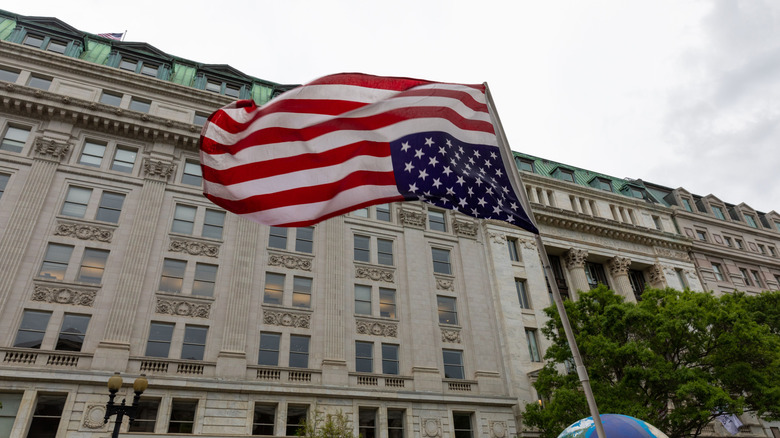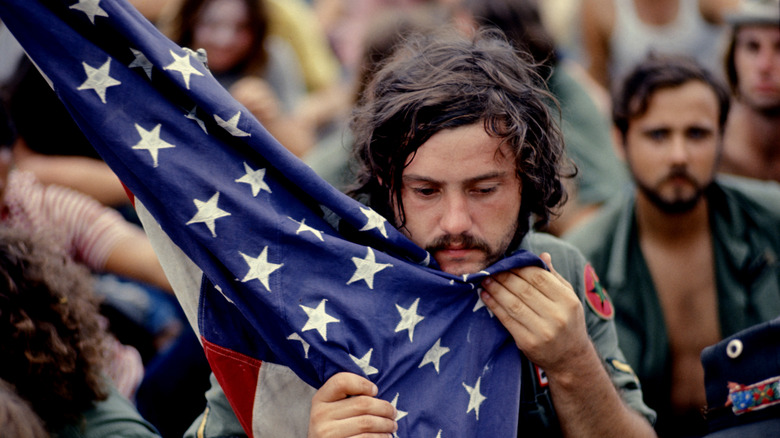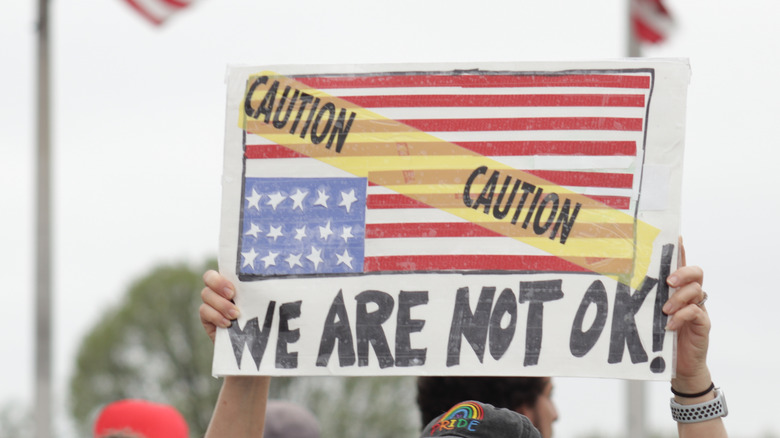The Meaning Of An Upside-Down Flag Explained
We all know that there's loads of laws regarding the United States flag, right? Citing U.S. Code, Title 4, chapter 1, § 8, Cornell Law School says that flags must not touch the ground, must not be carried horizontally, must not be embroidering onto cushions, must not cover ceilings, must not be used as clothing, and much more. The American Legion says that flags must be displayed near schools, public administrative buildings, police stations, must be hung to the right of other flags, and must be raised "briskly" and lowered "ceremoniously." The St. Lawrence County Government, which summarizes the full, immense, list of U.S. flag laws, is 45 pages long. And yet, you might have seen flags flipped upside down and the flag flippers not in jail. What's up with that?
First off, despite all of the U.S.' meticulous flag laws, it's not actually illegal to display a flag upside down. As Title 4 of the U.S. Code says, "The flag should never be displayed with the union down, except as a signal of dire distress in instances of extreme danger to life or property." This clause goes back to 1974, a socially tumultuous time in U.S. history towards the end of the Vietnam War. In the Supreme Court case Spence v. Washington, the court decreed that displaying an upside down flag was a form of protected First Amendment speech. This is why contemporary protestors have taken to displaying American flags upside down. The criterion of "extreme danger to life or property" is still up to interpretation, however.
A freedom granted towards the end of the Vietnam War
Hands down, the Vietnam War marked a breaking point in American public trust in their government. The war lasted from 1955 to 1975 and protests persisted en masse the entire time, especially from the mid-60s. Some protested the squandering of American lives and others protested the savaging of Vietnamese lives. Yet others protested the concept of war, generally speaking, or notions of American imperialism. And, Vietnam wasn't the only place that the U.S. invaded during a 20-year period. It invaded Cambodia in 1970 and had invaded Korea beforehand in 1950.
This was the environment that gave birth to the 1974 Supreme Court case, Spence v. Washington, which declared upside-down flags an allowed form of free speech. The case followed the deaths of four protestors at Kent State University in 1970 at the hands of Ohio National Guardsmen. Thousands of students rose in protest in direct response to both this occurrence and the U.S. invasion of Cambodia that year.
One student, Harold Omand Spence, stuck an American flag with peace signs made from black tape and hung the flag outside of his dorm, upside-down. As Justia quotes, the Supreme Court called him "hapless" and "over-exuberant." They said that he had no "evil intent" and his actions represented, "advocacy with which most people now rather wholeheartedly and well-nigh unanimously agree." Ultimately, they decided that altering the flag by affixing an image to it (a peace sign, in this case) was not okay, but inverting a flag as a symbolic form of expression was covered by the First Amendment.
Historical instances of turning flags upside down
Because the flag-flipping criterion of "extreme danger to life or property" is interpretable, common sense standards for the act have settled into place over time. Civil or political unrest is one obvious example of when flipping a flag is okay, provided that whatever's happening is serious enough. A flag could also be inverted to protest U.S. involvement in a war or some other conflict. If a hurricane sweeps through the neighborhood, obliterates infrastructure, and strands people at home, it's also okay to raise an upside-down flag as a kind of signal for help. Beyond these general guidelines, don't go waving an inverted flag around if someone steals your peanut butter and jelly sandwich or something.
On that note, there have been some legitimate historical epochs where Americans have raised upside-down flags to demonstrate dissatisfaction with social or political conditions. Prior to 1974's Spence v. Washington, the Civil Rights Movement in the 1960s saw people inverting flags. War protests during the '60s and '70s entire time, particularly against the Vietnam War, also saw protestors turning flags upside down. Harold Omand Spence's case came at the culmination of a history of protests involving flags.
In more recent times, protestors turned flags upside down following the terrorist attacks of 9/11, particularly during the Second Iraq War from 2003 to 2011 when U.S. forces invaded Iraq to overthrow Saddam Hussein. And very recently, protestors have flipped flags in response to governmental decisions made during President Donald Trump's second term.


